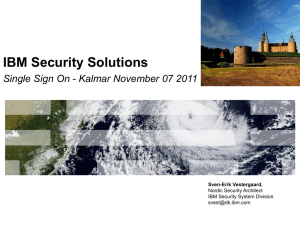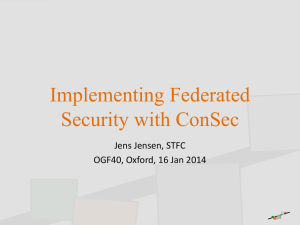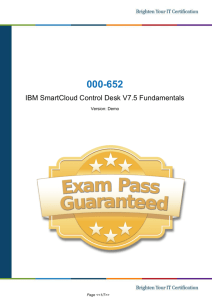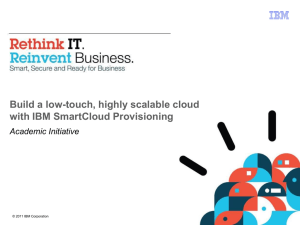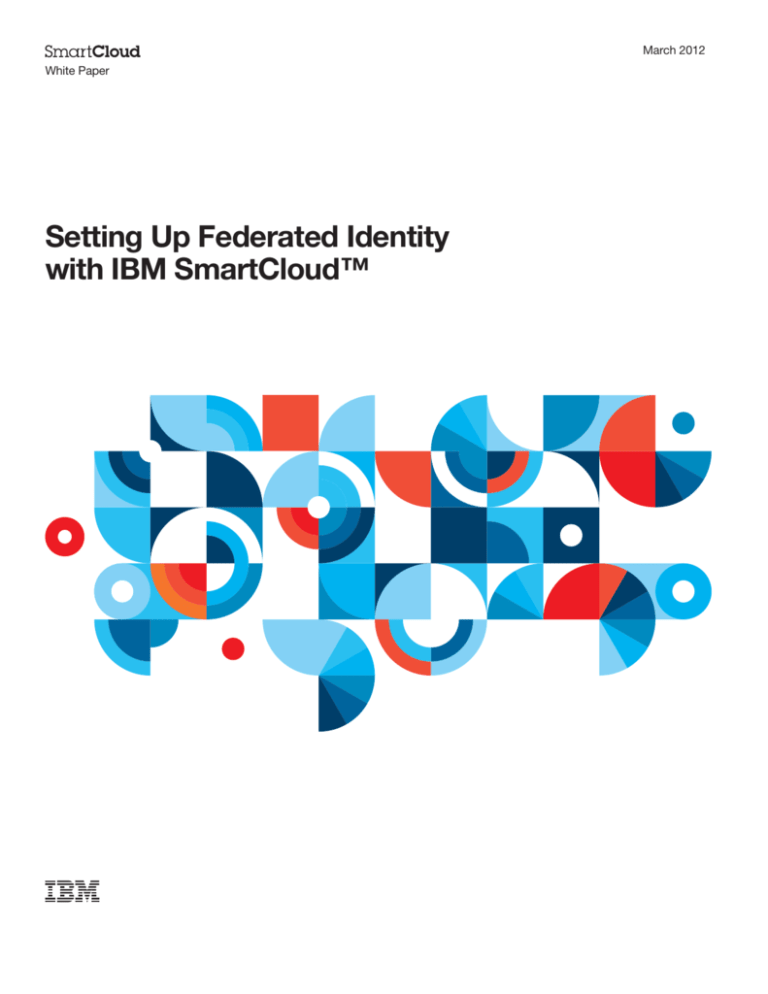
March 2012
White Paper
Setting Up Federated Identity
with IBM SmartCloud™
2
Setting Up Federated Identity with IBM SmartCloud
Notices
Contents
International Business Machines Corporation provides this
publication “as is” without warranty of any kind, either express
or implied. Some states do not allow disclaimer of express or
implied warranties in certain transactions; therefore this
statement may not apply to you.
3
1. Introduction to Federated Identity
3
1.1. What is Federated Identity?
4
1.2. Why SAML?
4
6
This publication may contain technical inaccuracies or
typographical errors. While every precaution has been taken
in the preparation of this document, the publisher and author
assume no responsibility for errors or omissions. Nor is any
liability assumed for damages resulting from the use of the
information contained herein. Changes are periodically made
to the information herein; these changes will be incorporated
in new editions of the publication. IBM may make
improvements and/ or changes in the product(s) and/or the
program(s) described in this publication at any time. IBM may
have patents or pending patent applications covering subject
matter in this document. The furnishing of this document
does not give you any license to these patents. You can send
license enquiries, in writing, to the IBM Director of
Commercial Relations, IBM Corporation. The following
terms, used in this publication, are trademarks or service
marks of corporations in the United States or other countries:
© Copyright IBM Corporation 2012. All rights reserved.
1.3. Identity Daisy Chains
2. Federated Identity in SmartCloud for Social Business
6
2.1. Who initiates the process?
7
2.2. Identity Federation Types
7
2.2.1. Organization Types
7
2.2.2. User Types
8
2.3. How SAML works
8
2.3.1. The authorization conversation
8
2.3.2. Trust Data Provided by the Identity
Provider to the Service Provider
9
2.3.3. Public Key & Trust Data Exchange
10
2.3.4. Constructing the SAML token
10
2.3.5. Sample SAML token
11
2.3.6. The SAML Form Post
11
2.4. SmartCloud for Social Business SAML Endpoints
11
2.5. Identity Provider SLA Responsibility
11
2.6. Using More Than One Identity Provider Source
12
3. Project Steps & Readiness Checklist
13
4. Additional Resource Links
13
4.1. Setting up Federated Identity for specific systems
13
4.1.1. Tivoli Federated Identity Manager
13
4.1.2. Microsoft Active Directory Federation
Services
13
4.1.3. Sun Access Manager
13
4.1.4. Novell
13
4.1.5. CA Federation Manager
13
4.2. General FID/SAML Resources
IBM Software Group
The most common use of federated identity is Multi-Domain
Single Sign On (MDSSO), or more simply, SSO. In the
general case, as a user moves from one domain (web site) to
another, the source site provides a token to assert that the user
is valid, and the destination site, based on the existence of a
previously defined trust relationship with the source, accepts
this assertion (once it’s verified that it’s genuine) and allows
the user access.
1. Introduction to Federated Identity
1.1. What is Federated Identity?
Federated identity is a general term that encompasses details
regarding how two or more organizations wish to share
identity information. A federated identity implementation
usually consists of a single system, the Identity Provider,
which authenticates a user and then vouches for the user’s
identity to other systems which do not have access to the
user’s authentication credentials. Federated Identity is based
on a trust relationship between an Identity Provider and a
Service Provider. The Identity provider owns the user
identities, controls the authentication of these identities, and
provides identity information. This would normally be a
directory server on the client’s premises, such as Tivoli or
Active Directory. The Service provider controls access to
services, trusts asserted identity information provided by the
Identity Provider, and provides access based on the asserted
identity. This is SmartCloud for Social Business.
The movement between sites may be explicit (i.e. the user
recognizes that the site is changing) or not. The important
thing is that the user is not asked to log into the destination
site. How the first site authenticated the user is not important
to the exchange of the identity information and assertion. The
user could have authenticated using a username & password
combination, through a token based authentication system, a
network password, or because access is being requested from
within a secure location. The first site considers the user valid,
Source web site
(Identity Provider)
Client.com
te
ica
1
Au
Business (Trust) Agreement
2
Ac
Destination web site
ce
ss
(Service Provider)
Pro
ibmcloud.com/social
tec
ted
Re
so
urc
e
General Single Sign On Use Case
Adapted from SAML v2.0 Technical Overview
http://www.oasis-open.org/committees/download.php/27819/sstc-saml-tech-overview-2.0-cd-02.pdf
Identity Information
nt
the
3
4
Setting Up Federated Identity with IBM SmartCloud
so it asserts to the second site that this is a valid user, and the
second site accepts this assertion based on the fact that it
trusts the source. It is important to note that when Federated
Identity is selected, both systems must be reachable by the
user in order for a user to access SmartCloud for Social
Business. If your Identity Server can’t be reached, there will be
no way to authenticate the user, and they will not be able to
access SmartCloud for Social Business services. SmartCloud
for Social Business currently supports federated identity with
outside parties using the Security Access Markup Language
(SAML 1.1). SAML is an open standard created by OASIS
(www.oasis-open.org), a non-profit consortium dedicated to
the creation of open standards for information security.
Identity Manager (TFIM) which has the capability to accept
identity tokens in a number of formats, including SAML 2.0,
OpenID, and WS-Federation. Thus, a choice existed. SAML
1.1 was chosen over the others due to a combination of factors
including its wide spread availability, security concerns raised
about some of the alternatives, and ease of implementation for
our clients.
Federated Identity using SAML is supported by a wide range
of commonly used directory servers, including:
•
•
•
Clients who create an identity federation with SmartCloud for
Social Business would be able to authenticate their users
however they wish, as long as they meet an acceptable
minimum standard, using any mechanism they want, from
passwords to Kerberos. Similarly, if a company has VPN or
in-office-only access restrictions to the location of the login
page, these restrictions are effectively inherited by
SmartCloud for Social Business because users need to access
the login page first. SmartCloud for Social Business does not
need to have your users’ passwords and no synchronization
with SmartCloud for Social Business is needed when users
change their password on the company directory.
1.2. Why SAML?
There are a number of competing approaches to Federated
Identity, including both proprietary and open standards.
Clearly proprietary standards are inappropriate for SaaS
offering, and amongst the various alternatives SAML is widely
considered the leading choice. In 2007, Gartner, an industry
analyst firm, declared SAML 2.0 “the de facto federation
standard across industries.”1
The Federated Identity services embedded within SmartCloud
for Social Business are provided by the Tivoli Federated
•
•
•
Tivoli (TAM/TFIM)
Active Directory (from Windows Server 2003 R2)
Novell
Sun Federated Access Manager (formerly Sun Access
Manager & Sun Federation Manager)
CA Federation Manager
And others.
1.3. Identity Daisy Chains
One of the advantages of Federated Identity, is that once a
system is certain that a user is who he claims to be, the Service
Provider can, in turn, become an Identity Provider to other
Service Providers. This allows SmartCloud for Social Business,
for example, to provide an assertion of identity that allows
users to access the component services within SmartCloud for
Social Business regardless of where a service is physically
located, or whether or not it can share the SmartCloud for
Social Business domain or, like with the email services,
operates using the client’s domain. Any current or future
service (including third party services) that may be offered as
part of SmartCloud for Social Business can be linked in this
manner, allowing users to move between them seamlessly. It
doesn’t matter which service the user starts his session with, or
how he might move around between services, as long as the
first authentication came from the user’s primary Identity
Provider – his or her company.
1Source: Gartner, Inc. “The U.S. Government’s Adoption of SAML 2.0 Shows Wide Acceptance”, by Gregg Kreizman, John Pescatore and Ray Wagner, October 29, 2007
IBM Software Group
Access IBMSmartCloud
(user dashboard)
Authenticated by
own Company
Access Individual
SmartCloud for Social Business
Services
Trusted Identity Assertion
Trusted Identity Assertion
(Identity Provider 1)
Trusted Identity
Assertion
IBMSmartCloud Connections
(Service Provider 2)
IBMSmartCloud iNotes
(Service Provider 2)
ibmcloud.com/social
Client.com
(Service Provider 1)
also
Acts as Identity Provider for
individual IBMSmartCloud
Services
5
Trusted Identity Assertion
IBMSmartCloud Events
(Service Provider 2)
Trusted Identity Assertion
IBMSmartCloud Engage
(Service Provider 2)
(Identity Provider 2)
Trusted Identity Assertion
IBMSmartCloud Meetings
(Service Provider 2)
IBMSmartCloud Internal Identity Federation
6
Setting Up Federated Identity with IBM SmartCloud
2. Federated Identity in SmartCloud for
Social Business
2.1. Who initiates the process?
The current public SAML specification (SAML 2.0) defines
two options. The first is referred to as the Identity Provider
Initiated model (IdP-Initiated), the second the Service
Provider model (SP-Initiated). SmartCloud for Social
Business currently implements SAML 1.1, and the IdPInitiated model only, in which the user must first go to his
Identity Provider, and the Identity Provider is responsible for
redirecting the user’s browser to the Service Provider
(SmartCloud for Social Business), with the SAML assertion of
identity, once the user has been authenticated. What this
means, in practical terms, is that clients using Federated
Identity with SmartCloud for Social Business must provide
one or more starting points for their users to access
SmartCloud for Social Business services. A starting point can
be an explicit login page, or could simply be a link on a
company Intranet site. The starting point could require the user
to (re)authenticate, or it could know that the user must have
been authenticated in order to have arrived at that point. A
company could provide both an internal starting point that does
not require the user to enter a user name and password, as well
as an external one that does – or can use other means to
determine if the user has already been authenticated and decide
whether or not to require a password at that time. If the
Identity Provider requires more than just a name and password
in order to authenticate on their end, then by extension
SmartCloud for Social Business access is protected by the same
security measure. Users of federated identity who go directly to
www.ibmcloud.com/social will not be able to log in, and
SmartCloud for Social Business will not be able to redirect
them to their appropriate starting points.
Identity Provider
Client.com
c
nti
the
1
2
en
wh
ate
c
i
t
n
the
Au
ate
2
Au
1
Ac
ce
Service Provider
ss
Attempt
ed
ask
Access
ibmcloud.com/social
Su
es
Suc
cee
sfu
lly
Identity Provider
Initiated
d in
Atte
mpt
Service Provider
Initiated
(requires SAML 2.0)
Differences in Initiation of Web Browser SSO
Adapted from SAML v2.0 Technical Overview
http://www.oasis-open.org/committees/download.php/27819/sstc-saml-tech-overview-2.0-cd-02.pdf
The SP-Initiated model is only available in SAML 2.0, which is not yet supported.
Identity Provider
Client.com
Service Provider
ibmcloud.com/social
3
cc
Identity Provider
Client.com
IBM Software Group
2.2. Identity Federation Types
SAML doesn’t solve everything, notably in the context of
email. The established protocols for POP, IMAP & SMTP, as
well as Lotus Sametime, do not support Federated Identity
concepts very well. To help overcome these limitations of
these older, established, mail protocols, SmartCloud for Social
Business offers several federation configuration options:
2.2.1. Organization Types
•
•
•
•
Non-Federated: An organization in which all subscribers will
authenticate with a username and password stored in
SmartCloud for Social Business. In this case SAML SSO is
not being used.
Federated: An organization in which all subscribers must
authenticate with their organization’s Identity Provider. Users
cannot change their password inside SmartCloud for Social
Business. In this case SAML SSO is being used.
Modified: An organization that will allow all subscribers to
authenticate with a username and password stored in
SmartCloud for Social Business or their organization’s
Identity Provider. In this case SAML SSO is being used, but
is optional.
Partial: An organization can have subscribers that are
Non-federated, Federated, or Modified. In this case SAML
SSO is being used, but if and how it is to be used is set
individually for each user.
7
The difference between Modified and Partial is that in a
Modified organization all users have the option to use either
authentication mechanism at any time. E.g. a user clicking
through from the company Intranet may be automatically
signed on using SAML, but going directly to www.ibmcloud.
com/social from home will be allowed to log in with their user
ID and password. Organizations defined as Partial have users
who carry one of the explicit designations below, which
controls the authentication process for the individual user.
2.2.2. User Types
•
•
•
Non-Federated: These are subscribers that use a username
and password to authenticate directly with SmartCloud for
Social Business. These users cannot use single sign on.
Federated: These are subscribers that will not have a
password in SmartCloud for Social Business and must
authenticate via their organization’s Identity Provider. For
these users SAML single sign on is mandatory.
Modified: Subscribers of this type will be able to authenticate
both with passwords stored in SmartCloud for Social
Business or by using their organizations Identity Provider via
SAML single sign on.
The Federation type for the organization should be specified
at the time the service is initially configured, as it will impact
the process of user on-boarding (e.g. federated users will not
be asked to supply an initial password), although it can be
changed later.
8
Setting Up Federated Identity with IBM SmartCloud
Identity Provider
End User
(IBMSmartCloud Customer)
(via web browser)
Service Provider
IBMSmartCloud
Services
(IBMSmartCloud)
1. Request Authorization
2. Authentcate
Login Page
(customer supplied)
3. Request IBMSmartCloud Access
4. XHTML form with SAML
response/redirect
5. POST signed SAML Response
7. IBMSmartCloud Response
6. Verify SAML response
and make access
decisions
8. End user access to IBMSmartCloud services
2.3. How SAML works
2.3.1. The authorization conversation
1. User accesses their organization’s intranet.
2. User authenticates with their organization’s intranet using
organizational standards for user authentication.
3. User requests access to SmartCloud for Social Business.
Typically this will happen by the user accessing an HTML
page that contains links to federation partners.
4. The user selects the SmartCloud for Social Business
federation. The SAML token is then created by the identity
provider and passed to the user’s web browser.
5. The user’s web browser is then redirected to the SmartCloud
for Social Business federation endpoint and the SAML token
is submitted via a form.
6. The SAML token is verified by SmartCloud for Social
Business and access to SmartCloud for Social Business
content is created for the user.
7. Secured SmartCloud for Social Business content is then sent
back to the user’s web browser.
8. User begins to interact with the SmartCloud for Social
Business services
2.3.2. Trust Data Provided by the Identity Provider to the
Service Provider
SAML is based on a private/public key system, so the key
element of the trust relationship is the exchange of the public
key, so the SAML tokens can be decoded and the signature
validated by SmartCloud for Social Business.
In order to establish the necessary trust relationship clients
need to supply to IBM:
•
•
•
•
Identity Provider Company Name
Contact Person: First and last name, email, phone
Provider ID: This is another name for the issuer element
that can be seen in the SAML token example below.
Typically, it is set as the URL where the assertion is being
sent from, but this can be any string. The purpose of this
value is just another way to verify by whom the token was
generated.
Intersite transfer service: The endpoint (a URL) on the
identity provider point of contact server where the sign-on
request process begins. This is the location to which users’
IBM Software Group
•
•
single sign-on requests are sent if the user arrives at the
service provider’s site first (as outlined in section 2.1).*
Artifact resolution service end point.*
The public key that belongs to the private/public pair that
is used to generate the digital signature placed in the SAML
assertion.
These two entries are optional in the current implementation,
as they are used for functions that are not yet supported.
However entries are need for these fields when setting up
the Federation. As they are usually set up anyhow when an
IdP is created, if the real values are available its best to
have them in the system for potential future use.
The public key certificate associated with the private key that
is used to sign the SAML messages created by the identity
provider, as well as other aspects of the initial exchange of
encrypted data. These data elements are highlighted in the
XML metadata file sample that follows in corresponding
colors.
2.3.3. Public Key & Trust Data Exchange
The public key and trust data described above can be provided
in one of two ways to IBM. The first way is for the information
to be sent in raw format (in a Java Key Store). The second
option for providing the partnership information is as part of a
SAML metadata file. The implementation in the SmartCloud
for Social Business environment will allow the metadata file
standard defined by SAML 2.0 to be imported. If you have an
implementation that exports metadata the public key will be in
it. Below is an example SAML metadata file for a SAML 1.1
identity provider. The highlighted URLs in the example below
will be specific to each identity provider, and need to be set
according to the local IdP configuration.
<?xml version=”1.0” encoding=”UTF-8” ?>
<md:EntityDescriptor xmlns:md=”urn:oasis:names:tc:SAML:2.0:metadata”
entityID=”https://ghvmdev019.clientco.com/FIM/sps/SAML/saml11”>
<md:IDPSSODescriptor protocolSupportEnumeration=”urn:oasis:names:tc:SAML:1.1:protocol”>
<md:KeyDescriptor use=”signing”>
<KeyInfo xmlns=”http://www.w3.org/2000/09/xmldsig#”>
<X509Data>
<X509Certificate>...public key goes here...</X509Certificate>
</X509Data>
</KeyInfo>
</md:KeyDescriptor>
<md:ArtifactResolutionService Binding=”urn:oasis:names:tc:SAML:1.0:bindings:SOAP- binding”
Location=”http://ghvmdev019.clientco.com/FIM/sps/SAML/saml11/soap” index=”0”
isDefault=”true” />
<md:SingleSignOnService Binding=”urn:oasis:names:tc:SAML:1.0:profiles:artifact-01”
Location=”http://ghvmdev019.clientco.com/FIM/sps/SAML/saml11/login” />
<md:SingleSignOnService Binding=”urn:oasis:names:tc:SAML:1.0:profiles:browserpost” Location=”http://ghvmdev019.clientco.com/FIM/sps/SAML/saml11/login” />
</md:IDPSSODescriptor>
<md:Organization>
<md:OrganizationName xml:lang=”en”>ClientCo</md:OrganizationName>
<md:OrganizationDisplayName xml:lang=”en”>ClientCo</md:OrganizationDisplayName>
<md:OrganizationURL xml:lang=”en”>https://ghvmdev019.clientco.com/FIM/LLFITest</md:OrganizationURL>
</md:Organization>
<md:ContactPerson contactType=”technical”>
<md:Company>ClientCo</md:Company>
<md:GivenName>John</md:GivenName>
<md:SurName>Smith</md:SurName>
<md:EmailAddress>jsmith@clientco.com</md:EmailAddress>
<md:TelephoneNumber>1-555-123-4567</md:TelephoneNumber>
</md:ContactPerson>
</md:EntityDescriptor>
9
10
Setting Up Federated Identity with IBM SmartCloud
2.3.4. Constructing the SAML token
SmartCloud for Social Business accepts SAML 1.1 tokens.
These tokens should be signed by an XML signature method
and contain the email address of the user who is being
authenticated. The SAML assertion contains 5 major parts
that will be expected in the SAML assertions provided to the
SmartCloud for Social Business endpoint. These five parts are
highlighted in the sample token below, and can be defined as:
1. Issuer – Identifier for the Identity Provider
2. Signature – Digital signature of the Identity Provider
3. Subject – Identifies the authenticated principal
4. Conditions – States the conditions under which the assertion
is valid
5. AuthnStatement – Describes how authentication was
performed on identity provider
Presently SmartCloud for Social Business’ Federated Identity
only requires an assertion of the user’s email. This email
assertion will be used by SmartCloud for Social Business to
provide access to the user’s account for all services.
The typical scenario will be for the identity provider to
provide the user’s email as the subject of the message. The
SmartCloud for Social Business environment allows for XML
transformations which will allow the user email to be
extracted from any part of the SAML token, but the email
must be included in the token based on SmartCloud for Social
Business’ current implementation.
SmartCloud for Social Business does not require any
additional KeyInfo elements in the XML signatures written to
the SAML token. These xml elements will be ignored if
included because SmartCloud for Social Business requires the
Public Key to be provided when partnership is setup.
2.3.5. Sample SAML token
Here is an example XML SAML token that will be acceptable
for SmartCloud for Social Business federation identity:
<samlp:Response xmlns:ds=”http://www.w3.org/2000/09/xmldsig#” xmlns:saml=”urn:oasis:names:tc:SAML:1.0:assertion” xmlns:samlp=”urn:oasis:nam
es:tc:SAML:1.0:protocol” IssueInstant=”2009-06- 10T20:20:21Z” MajorVersion=”1” MinorVersion=”1” Recipient=”https://apps.lotuslive.com/sps/sp/
saml11/login” ResponseID=”FIMRSP_cbd4130a-0121-12af b299-fbcc161dfd41”>
<ds:Signature Id=”uuidcbd4130b-0121-13c2-85f7-fbcc161dfd41”>
Digital signature of the Identity Provider goes here
</ds:Signature>
<samlp:Status>
<samlp:StatusCode Value=”samlp:Success” />
</samlp:Status>
<saml:Assertion AssertionID=”Assertion-uuidcbd41304-0121-1088-bca7-fbcc161dfd41” IssueInstant=”2009-06-10T20:20:21Z” Issuer=”
https://ghvmdev019.clientco.com/FIM/sps/SAML/saml11” MajorVersion=”1” MinorVersion=”1”>
<saml:Conditions NotBefore=”2009-06-03T21:40:21Z” NotOnOrAfter=”2009-06-17T19:00:21Z”>
<saml:AudienceRestrictionCondition>
<saml:Audience>https://apps.lotuslive.com/sps/sp/saml11</saml:Audience>
</saml:AudienceRestrictionCondition>
</saml:Conditions>
<saml:AuthenticationStatement AuthenticationInstant=”2009-06-10T20:20:21Z”
AuthenticationMethod=”urn:oasis:names:tc:SAML:1.0:am:password”>
<saml:Subject>
<saml:NameIdentifier Format=”urn:oasis:names:tc:SAML:1.0:assertion#emailAddress”> jsmith@clientco.com</saml:NameIdentifier>
<saml:SubjectConfirmation>
<saml:ConfirmationMethod>urn:oasis:names:tc:SAML:1.0:cm:bearer</saml:ConfirmationMethod>
</saml:SubjectConfirmation>
</saml:Subject>
</saml:AuthenticationStatement>
</saml:Assertion>
</samlp:Response>
IBM Software Group
2.3.6. The SAML Form Post
The identity provider creates a form that is posted to the
SmartCloud for Social Business SAML endpoint. Here is an
example form that is used by TFIM:
11
2.4. SmartCloud for Social Business SAML
Endpoints
The SmartCloud for Social Business SAML endpoint, where
SAML token is posted to once the Identity Provider has
authenticated the user, is:
https://apps.lotuslive.com/sps/sp/saml11/login
<!DOCTYPE HTML PUBLIC “-//W3C//DTD XHTML 1.1//EN” “http://
www.w3.org/TR/xhtml11/DTD/xhtml11.dtd”>
<html xml:lang=”en” xmlns=”http://www.w3.org/1999/xhtml”>
<head>
<script language=”JavaScript”>
<!-document.cookie = “IV_JCT=%2FFIM; path=/”;
//-->
</script>
<meta http-equiv=”Content-Type” content=”text/html;
charset=UTF-8”>
<title>SAML POST response</title>
</head>
<body>
<form method=”post” action=”https://apps.lotuslive.com/sps/sp/
saml11/login”>
<p>
<input name=”TARGET” value=”https://apps.lotuslive.com”
type=”hidden”>
<input name=”SAMLResponse” value=”PHNhbWxwOlJlc3Bv
bnNlIHhtbG5zOmRzP SJodHRwOi8vd3d3LnczLm9yZy8yM
DAwLzA5L3htbGRzaWcjIiB4bWxuczpzYW1sPSJ1cm46b
2FzaXM6bmFtZXM6dGM6U0FNTDoxLjA
.
This is the encoded XML SAML token
.
WZpY2F0ZT48L2RzOlg1MDlEYXRhPjwvZHM6S2V5SW5m
bz48L2RzOlNpZ25hdHVyZT48L3NhbWw6QXNzZXJ0aW
9uPjwvc2FtbHA6UmVzcG9uc2U+“ type=”hidden”>
<noscript>
<button type=”submit”>POST</button>
<!-- included for requestors that do not support javascript -->
</noscript>
</p>
</form>
<script type=”text/javascript”>
var signOnText = ‘Please wait, signing on...’;
document.write(signOnText);
setTimeout(‘document.forms[0].submit()’, 0);
</script>
Please wait, signing on...
</body>
</html>
The SmartCloud for Social Business target is (where the user’s
browser is then redirected to):
https://apps.lotuslive.com
SmartCloud for Social Business federated identity support
assumes communication between the Identity Provider and
SmartCloud for Social Business over public internet. SSL 3.0
is used to secure this communication channel.
2.5. Identity Provider SLA Responsibility
Clients opting for federated identity must recognize that their
system is a critical component of access to the SmartCloud for
Social Business system. Their users will not be able to access
SmartCloud for Social Business services, which may include
their mail boxes, if the Identity Provider (IdP) service is down
or cannot be reached for any other reason. The customer is
responsible for providing a logon page and the SAML IdP
which achieves an SLA at least as good as the contract SLA for
the services. Outages of the customer provided login page and
SAML IdP shall be excluded from any SLA availability
calculation.
2.6. Using More Than One Identity Provider Source
If your organization has more than one directory server for
the same domain they do not necessarily need to be
consolidated into one Identity Provider (IdP). SmartCloud for
Social Business Federated Identity can accept tokens from
multiple IdPs on the same domain, as long as they are all
signed with the same digital signature. However, if this is
necessary, it is advisable to bring this up early in the process so
the compatibility of your IdP layout, with SmartCloud for
Social Business, can be validated prior to starting the
implementation.
12
Setting Up Federated Identity with IBM SmartCloud
3. Project Steps & Readiness Checklist
•
Are there any reasons (e.g. security, network configuration)
that would prevent your directory server from being reached
from outside the firewall, to provide the necessary service? If
security concerns will prevent your primary directory from
being reachable for all the necessary cases, consider mirroring
only the necessary data set onto another directory server that
can be placed in a position with the necessary access available.
•
Does the directory server hardware (and network) have
capacity to accept the additional workload?
•
As the Identity Provider, your set up should be complete, and
tested, before providing your trust relationship data to IBM.
An end to end test can be performed by setting up a dummy
service provider on spare hardware either using your existing
software (i.e. the same directory server) or by downloading
and setting up a free implementation from a source such as
OpenSAML (see links in next section).
•
Purchase the necessary certificates. Although self-signed
certificates can be used, and are good for testing, browsers
react badly to them and can confuse users with dire sounding
warnings, and repeated requests to trust the certificate.
•
Add SmartCloud for Social Business as an allowed service for
SAML authorization.
•
Supply the trust relationship information package to IBM
Here is a brief outline of the steps, and items needed, to get
Federated Identity set up. Any of these steps may need to be
expanded, in your environment, into a small project to prepare
the system. A readiness assessment should be done in advance
of planning an implementation of Federated Identity,
following this list.
•
Are you currently using a directory server, such as TDS or
AD, and is your directory server ready to support SAML
based Federated Identity?
•
Are your users all using/on the (or a) directory server? While
it is not necessary for all users to be on a consolidated
directory, if users are widely distributed over many servers (or
some users are not on any) then it will be worth investigating
the impact of directory consolidation before trying to set up
Federated Identity.
•
If you are using multiple directory servers, are any in remote
locations that will have slow or unreliable connections to
where remote users of SmartCloud for Social Business might
be logging in from? If access to a directory in Peru is
unreliable from New York, this is not necessarily a problem if
the server will be reliably available to employees in Peru. On
the other hand, if a server in New York is hard to reach for
mobile employees who are on assignment in Peru, it may be
preferable not to federate those users. This step can help you
determine what federation type you will need to set up.
IBM Software Group
13
4. Additional Resource Links
4.1.3. Sun Access Manager
4.1. Setting up Federated Identity for specific
systems
http://developers.sun.com/identity/reference/techart/sso.html
The following links may assist you in finding the information
you need to set up SAML services with a number of the
directory servers in the market today. These links are provided
for your information only.
4.1.4. Novell
http://developer.novell.com/wiki/index.php/Novell_SAML_
Toolkit
4.1.5. CA Federation Manager
Please consult your product’s manuals.
https://support.ca.com/irj/portal/anonymous/
DocumentationResults
4.1.1. Tivoli Federated Identity Manager
http://publib.boulder.ibm.com/infocenter/tivihelp/v2r1/index.
jsp?topic=/com.ibm.tivoli.fi m.doc_6.2/welcome.htm
4.2. General FID/SAML Resources
Wikipedia entry for a basic explanation of SAML
http://en.wikipedia.org/wiki/SAML
http://www.redbooks.ibm.com/abstracts/sg246014.html?Open
http://www.redbooks.ibm.com/abstracts/sg246394.html?Open
Oasis Group, the origin of SAML:
http://www.oasis-open.org/committees/tc_home.php?wg_
abbrev=security
http://www.redbooks.ibm.com/abstracts/redp3678.html?Open
http://www.oasis-open.org/committees/security
http://www.redbooks.ibm.com/abstracts/redp4354.html?Open
4.1.2. Microsoft Active Directory Federation Services
ADFS Deployment Guide:
http://technet.microsoft.com/en-us/library/cc758030(WS.10).
aspx
Implementing Your ADFS Design Plan:
http://technet.microsoft.com/en-us/library/cc782250(WS.10).
aspx
Others:
http://www.microsoft.com/downloads/details.
aspx?familyid=062F7382-A82F-44289BBDA103B9F27654&displaylang=en
http://msdn.microsoft.com/en-us/magazine/cc163520.aspx
http://technet.microsoft.com/en-ca/magazine/2006.07.
simplify.aspx
Online community and information resource for the SAML
OASIS Standard:
http://saml.xml.org/
OpenSAML – Open source SAML libraries in Java and C++.
http://www.OpenSAML.org/
Presentation on SAML 2.0
http://www.parleys.com/display/PARLEYS/Home#talk=7602
261;slide=1;title=SAML%20v2
Presentation on SAML
http://www.infoq.com/presentations/samlal Resource Links
© Copyright IBM Corporation 2012
IBM Corporation
IBM Software Group
Somers,NY
Produced in the United States of America
References in this publication to IBM products or services do not imply
that IBM intends to make them available in all countries in which IBM
operates. The information is provided “as is” without warranty of any kind,
express or implied and is based on IBM’s current product plans and strategy,
which are subject to change by IBM without notice. IBM shall not be
responsible for any damages
Please Recycle
BCE-01565-USEN-00

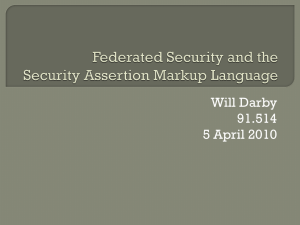
![[#SSPCPP-641] add ability to set SOAP client protocols and cipher](http://s3.studylib.net/store/data/007524050_2-01fcbefd1bbaa532824fc82d6f4c29d0-300x300.png)
